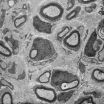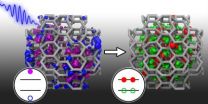(Press-News.org) Addiction may result from abnormal brain circuitry in the frontal cortex, the part of the brain that controls decision-making. Researchers from the RIKEN Center for Molecular Imaging Science in Japan collaborating with colleagues from the Montreal Neurological Institute of McGill University in Canada report today that the lateral and orbital regions of the frontal cortex interact during the response to a drug-related cue and that aberrant interaction between the two frontal regions may underlie addiction. Their results are published today in the journal Proceedings of the National Academy of Sciences of the USA.
Cues such as the sight of drugs can induce cravings and lead to drug-seeking behaviors and drug use. But cravings are also influenced by other factors, such as drug availability and self-control. To investigate the neural mechanisms involved in cue-induced cravings the researchers studied the brain activity of a group of 10 smokers, following exposure to cigarette cues under two different conditions of cigarette availability. In one experiment cigarettes were available immediately and in the other they were not. The researchers combined a technique called transcranial magnetic stimulation (TMS) with functional magnetic resonance imaging (fMRI).
The results demonstrate that in smokers the orbitofrontal cortex (OFC) tracks the level of craving while the dorsolateral prefrontal cortex (DPFC) is responsible for integrating drug cues and drug availability. Moreover, the DPFC has the ability to suppress activity in the OFC when the cigarette is unavailable. When the DPFC was inactivated using TMS, both craving and craving-related signals in the OFC became independent of drug availability.
The authors of the study conclude that the DLPFC incorporates drug cues and knowledge on drug availability to modulate the value signals it transmits to the OFC, where this information is transformed into drug-seeking action.
"We demonstrate that in smokers, cravings build up in the OFC upon processing of cigarette cues and availability by the DFPC. What is surprising is that this is a neural circuit involved in decision making and self-control, that normally guides individuals to optimal behaviors in daily life." Explains Dr. Hayashi, from RIKEN, who designed and conducted the fMRI and TMS experiments.
"This research uncovers the brain circuitry responsible for self-control during reward-seeking choices. It is also consistent with the view that drug addiction is a pathology of decision making." According to Dr. Alain Dagher, a neurologist at the Montreal Neurological Institute.
These findings will help understand the neural basis of addiction and may contribute to a therapeutic approach for addiction.
###
For more information please contact:
Juliette Savin
Global Relations Office
RIKEN
Tel: +81-(0)48-462-1225 / Fax: +81-(0)48-463-3687
email: pr@riken.jp
Reference
Takuya Hayashi, Ji Hyun Ko, Antonio P. Strafella, Alain Dagher
"Dorsolateral prefrontal and orbitofrontal cortex interactions during self-control of cigarette craving." PNAS January 2013, DOI:10.1073/pnas.1212185110
About RIKEN
RIKEN is Japan's flagship research institute devoted to basic and applied research. Over 2500 papers by RIKEN researchers are published every year in reputable scientific and technical journals, covering topics ranging across a broad spectrum of disciplines including physics, chemistry, biology, medical science and engineering. RIKEN's advanced research environment and strong emphasis on interdisciplinary collaboration has earned itself an unparalleled reputation for scientific excellence in Japan and around the world.
Website: http://www.riken.jp/ Find us on Twitter at @rikenresearch
About the RIKEN Center for Molecular Imaging Science:
RIKEN Center for Molecular Imaging Science (CMIS), located in Kobe approximately 500 km west of Tokyo, is one of the core institutions in the nation-wide network for molecular imaging research. Using a range of molecular imaging technology, in particular PET and MRI, CMIS evaluates newly developed molecular probes and their functions, and develops new imaging techniques to analyze molecular dynamics and tissue function, all with the aim to accelerate the pre-clinical processes for novel therapeutics and drug discovery.
New research uncovers the neural mechanism underlying drug cravings
2013-01-29
ELSE PRESS RELEASES FROM THIS DATE:
Hospital patient loads often at unsafe levels, physician survey says
2013-01-29
Nationwide, more than one-quarter of hospital-based general practitioners who take over for patients' primary care doctors to manage inpatient care say their average patient load exceeds safe levels multiple times per month, according to a new Johns Hopkins study. Moreover, the study found that one in five of these physicians, known as hospitalists, reports that their workload puts patients at risk for serious complications, or even death.
The research, reported in JAMA Internal Medicine, comes as health care systems anticipate an influx of new patients generated by the ...
Researchers find genes behind aggressive endometrial cancer
2013-01-29
New Haven, Conn. — In a major breakthrough for uterine serous carcinoma (USC) — a chemo-resistant, aggressive form of endometrial cancer, Yale researchers have defined the genetic landscape of USC tumors, findings that point to new treatment opportunities.
The collaborative team—which included researchers with expertise in gynecological cancer, genomics, and computational biology— identified a number of new genes that are frequently mutated in USC. The results of this comprehensive genetic analysis of USC are published in the Jan. 28 Proceedings of the National Academy ...
Slow-release 'jelly' delivers drugs better
2013-01-29
DURHAM, NC -- Duke University biomedical engineers have developed a new delivery system that overcomes the shortcomings of a promising class of peptide drugs – very small proteins – for treating diseases such as diabetes and cancer.
There are more than 40 peptide drugs approved for use in humans and more than 650 are being tested in clinical studies. One example is the hormone insulin, a peptide that regulates the metabolism of carbohydrates in the body and is used as a drug to treat diabetes.
Despite their effectiveness, peptide drugs cannot achieve their full potential ...
Public report national audit of percutaneous coronary interventional procedures 2011
2013-01-29
The 2011 annual report of the National Audit of Percutaneous Coronary Intervention (PCI) highlights the significant progress within hospitals to expand PCI services to treat more patients with acute coronary syndromes.
PCI mechanically improves blood flow to the heart and can be used to relieve the symptoms of angina, prevent and treat heart attacks. When used to treat heart attack patients, the procedure is called primary PCI. Commissioned and funded by the Healthcare Quality Improvement Partnership, the National Audit of PCI is clinically led by the British Cardiovascular ...
Cardiac disease linked to higher risk of mental impairment, Mayo Clinic finds
2013-01-29
ROCHESTER, Minn. -- Cardiac disease is associated with increased risk of mild cognitive impairment such as problems with language, thinking and judgment -- particularly among women with heart disease, a Mayo Clinic study shows. Known as nonamnestic because it doesn't include memory loss, this type of mild cognitive impairment may be a precursor to vascular and other non-Alzheimer's dementias, according to the findings published online Monday in JAMA Neurology.
Mild cognitive impairment is an important stage for early detection and intervention in dementia, says lead author, ...
New research will help shed light on role of Amazon forests in global carbon cycle
2013-01-29
The Earth's forests perform a well-known service to the planet, absorbing a great deal of the carbon dioxide pollution emitted into the atmosphere from human activities. But when trees are killed by natural disturbances, such as fire, drought or wind, their decay also releases carbon back into the atmosphere, making it critical to quantify tree mortality in order to understand the role of forests in the global climate system. Tropical old-growth forests may play a large role in this absorption service, yet tree mortality patterns for these forests are not well understood. ...
The tales teeth tell
2013-01-29
For more than two decades, scientists have relied on studies that linked juvenile primate tooth development with their weaning as a rough proxy for understanding similar developmental landmarks in the evolution of early humans. New research from Harvard, however, is challenging those conclusions by showing that tooth development and weaning aren't as closely related as previously thought.
Using a first-of-its-kind method, a team of researchers led by professors Tanya Smith and Richard Wrangham and Postdoctoral Fellow Zarin Machanda of Harvard's Department of Human Evolutionary ...
Glial cells assist in the repair of injured nerves
2013-01-29
This press release is available in German.
Unlike the brain and spinal cord, the peripheral nervous system has an astonishing capacity for regeneration following injury. Researchers at the Max Planck Institute of Experimental Medicine in Göttingen have discovered that, following nerve damage, peripheral glial cells produce the growth factor neuregulin1, which makes an important contribution to the regeneration of damaged nerves.
From their cell bodies to their terminals in muscle or skin, neuronal extensions or axons in the peripheral nervous system are surrounded ...
EARTH: Drinking toilet water
2013-01-29
Alexandria, VA – Would you drink water from a toilet? What if that water, once treated, was cleaner than what comes out of the faucet? Although the imagery isn't appealing, as climate change and population growth strain freshwater resources, such strategies are becoming more common around the world — and in the United States.
Over the last several decades, local and regional water shortages have become increasingly common. These shortages have led to increased friction over water resources. Technologies are currently being developed to help make wastewater recycling ...
1 in, 2 out: Simulating more efficient solar cells
2013-01-29
Using an exotic form of silicon could substantially improve the efficiency of solar cells, according to computer simulations by researchers at the University of California, Davis, and in Hungary. The work was published Jan. 25 in the journal Physical Review Letters.
Solar cells are based on the photoelectric effect: a photon, or particle of light, hits a silicon crystal and generates a negatively charged electron and a positively charged hole. Collecting those electron-hole pairs generates electric current.
Conventional solar cells generate one electron-hole pair ...



